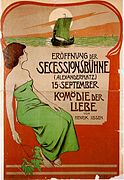
Jugendstil was an artistic movement, particularly in the decorative arts, that was influential primarily in Germany and elsewhere in Europe to a lesser extent from about 1895 until about 1910. It was the German counterpart of Art Nouveau. The members of the movement were reacting against the historicism and neo-classicism of the official art and architecture academies. It took its name from the art journal Jugend, founded by the German artist Georg Hirth. It was especially active in the graphic arts and interior decoration.
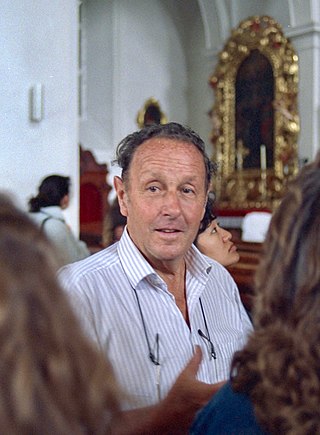
Armin Hofmann (HonRDI) was a Swiss graphic designer. He was one of the most prominent individuals in Swiss design.

The Neue Galerie New York is a museum of early twentieth-century German and Austrian art and design located in the William Starr Miller House at 86th Street and Fifth Avenue in New York City. Established in 2001, it is one of the most recent additions to New York City's famed Museum Mile, which runs from 83rd to 105th streets on Fifth Avenue in the Upper East Side of Manhattan.
Less is more is a principle found in several traditions. Its basic meaning is to keep things simple, similar to the concept of minimalism. Its use in architecture emerges from the idea that simplicity and clarity lead to good design. The concept is often associated with the modernism movement in architecture and design, although it can be applied to many fields, including art, literature, music, and lifestyle.

Lucian Bernhard was a German graphic designer, type designer, professor, interior designer, and artist during the first half of the twentieth century.

The Museum der bildenden Künste is a museum in Leipzig, Saxony, Germany. It covers artworks from the Late Middle Ages to Modernity.
Graphic design is the practice of combining text with images and concepts, most often for advertisements, publications, or websites. The history of graphic design is frequently traced from the onset of moveable-type printing in the 15th century, yet earlier developments and technologies related to writing and printing can be considered as parts of the longer history of communication.

Hans Unger was a German painter who was, during his lifetime, a highly respected Art Nouveau artist. His popularity did not survive the change in the cultural climate in Germany after World War I, however, and after his death he was soon forgotten. However, in the 1980s interest in his work revived, and a grand retrospective exhibition in 1997 in the City Museum in Freital, Germany, duly restored his reputation as one of the masters of the Dresden art scene around 1910.
Ludwig Hohlwein was a German poster artist, a pioneer of the Sachplakat style. He trained and practiced as an architect in Munich before he switched to poster design.
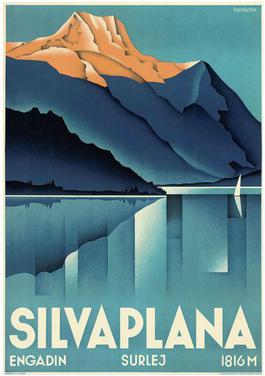
Johannes Handschin a.k.a. Hans Handschin (1899–1948) was a noted Swiss artist and one of the leaders of the Basel graphic art movement known for their art deco posters.
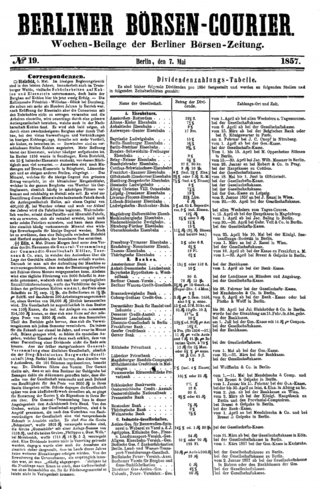
The Berliner Börsen-Courier was a German left-liberal daily newspaper published from 1868 to 1933. It focused primarily on prices of securities traded on the stock exchanges and securities information about the mortgage market, but also featured news and reports from industry, commerce, politics and culture. It was subtitled: moderne Tageszeitung für alle Gebiete.
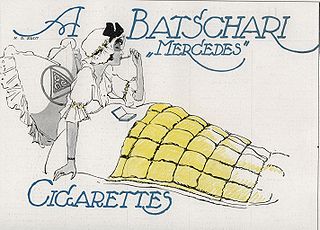
The Zigarettenfabrik A. Batschari was a German cigar and cigarette manufacturer established in 1834 in Baden-Baden by August Batscharis. Along with other cigarette manufacturers of the period like Josef Garbáty and Manoli, Batschari was at the time a patron of the arts, employing famous artists such as Hans Rudi Erdt, Ivo Puhonny, Lucian Bernhard and Ludwig Hohlwein to produce advertising material. Today, vintage Batschari enamel signs, glass plates, cigarette boxes and posters are popular collectors' items.

Hans Rudi Erdt was a German graphic designer, lithographer and commercial artist known for his contributions to the Sachplakat movement created by Lucian Bernhard. His work at the prestigious Hollerbaum und Schmidt art printing company along with Edmund Edel, Hans Lindenstadt, Julius Klinger, Julius Gipkens, Paul Scheurich and Karl Schulpig make him one of the most important representatives of German poster art between 1906 and 1918. Erdt has also been recognized for his innovative use of typography in posters.
Nancy Stahl is an American illustrator.
Julius E. F. Gipkens was a German painter, illustrator and graphic designer.
Hans Sachs (1881-1974) was a Berlin dentist whose greatest accomplishment came from his passion for posters. He was the leading founder of an important group devoted to collecting posters which started an influential poster magazine. Before the seizure of his collection of 12,500 posters during Kristallnacht on 9 November 1938, he had the largest collection of posters in Germany, probably in the world. He was able to escape to the United States, but he never regained possession of the posters. After years of court battles, 4,344 posters were returned to his son in 2013. Some will be given to museums, but most have been or will be sold at auction.

Nazi architecture is the architecture promoted by Adolf Hitler and the Nazi regime from 1933 until its fall in 1945, connected with urban planning in Nazi Germany. It is characterized by three forms: a stripped neoclassicism, typified by the designs of Albert Speer; a vernacular style that drew inspiration from traditional rural architecture, especially alpine; and a utilitarian style followed for major infrastructure projects and industrial or military complexes. Nazi ideology took a pluralist attitude to architecture; however, Hitler himself believed that form follows function and wrote against "stupid imitations of the past".
Ernst Aufseeser (1880–1940) was a German painter, illustrator and graphic designer. His design work included trademarks, stamps, book covers, typography, posters and textiles.

Art Nouveau posters and graphic arts flourished and became an important vehicle of the style, thanks to the new technologies of color lithography and color printing, which allowed the creation of and distribution of the style to a vast audience in Europe, the United States and beyond. Art was no longer confined to art galleries, but could be seen on walls and illustrated magazines.
Joseph Binder was an Austrian graphic designer and painter. He is recognized as one of the pioneers of the modern poster, noted for his refined, stylized images and high-impact colors. Some of his best known works include posters for the 1939 New York World’s Fair, the U.S. Army Air Corps and the American Red Cross.

